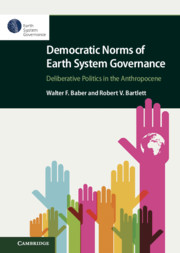Book contents
- Democratic Norms of Earth System Governance
- Democratic Norms of Earth System Governance
- Copyright page
- Contents
- Table
- Acknowledgments
- 1 Democratic Governance in the Anthropocene
- 2 Toward Consensual Earth System Governance
- 3 Empowered Democratic Agency in the Anthropocene
- 4 Embedded Governance Architecture in the Anthropocene
- 5 Experimental Adaptiveness in the Anthropocene
- 6 Equivocal Democratic Accountability in the Anthropocene
- 7 Equitable Access and Allocation in the Anthropocene
- 8 Earth System Democracy
- Afterword
- Notes
- Bibliography
- Index
4 - Embedded Governance Architecture in the Anthropocene
The Structure of Institutionalized Ecological Rationality
Published online by Cambridge University Press: 12 August 2021
- Democratic Norms of Earth System Governance
- Democratic Norms of Earth System Governance
- Copyright page
- Contents
- Table
- Acknowledgments
- 1 Democratic Governance in the Anthropocene
- 2 Toward Consensual Earth System Governance
- 3 Empowered Democratic Agency in the Anthropocene
- 4 Embedded Governance Architecture in the Anthropocene
- 5 Experimental Adaptiveness in the Anthropocene
- 6 Equivocal Democratic Accountability in the Anthropocene
- 7 Equitable Access and Allocation in the Anthropocene
- 8 Earth System Democracy
- Afterword
- Notes
- Bibliography
- Index
Summary
To endure, policies and institutions that both protect the environment and promote human security must have an architecture based on principles that lead to creation and maintenance of a rational relationship between human places and human practices.Flexibility and open texture allow meaning to change and endure over time, as both times and people change, and to remain embedded in its cultural context.In every corner of the globe, people have devised small pieces of institutional architecture that show remarkable creativity and potential for expansion.The objective should not be replicating these experiences at grander and higher scales, nor achieving greater levels of consistency or integration in governance architecture.Instead, consilience is what should be sought in our environmental governance architecture – a greater level of coherence in our knowledge.This is the level of democratic discourse, which depends on a more solid and substantive level of explanation – grounded in holistic social experimentation – for both its subject matter and its evaluative criteria.
Keywords
- Type
- Chapter
- Information
- Democratic Norms of Earth System GovernanceDeliberative Politics in the Anthropocene, pp. 77 - 103Publisher: Cambridge University PressPrint publication year: 2021



